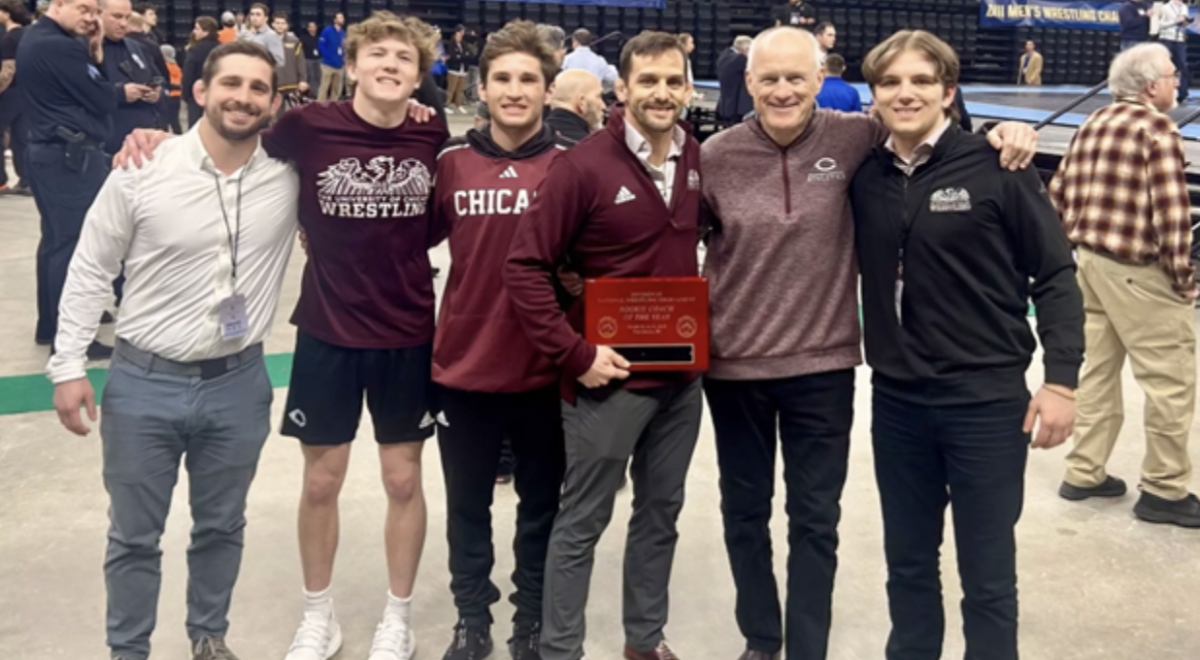A cup of tea, a warm shower, or chocolate bars don’t exactly do the trick for third-year Meg Allison when she’s having a bad day. When Allison is stressed, all she needs is a good tackling practice with the rugby team.
Allison is the hearty co-captain behind the U of C Women’s Rugby Football Club—a band of about 20 women who can be found throwing each other around three times a week on the Midway. Although the sport involves rough contact, the players are still touchy-feely. A difficult pass will be high-fived, a player will lend an opponent a hand after a ruthless tackle, and—perhaps surprisingly for athletes accustomed to deep-seated inter-team rivalry—the opponents will party together in a post-game drink-up.
“The best part about it is rugby culture, where you beat the crap out of the opposing team and then go party with them,” said Allison, a third-year and the rugby co-captain.
And beat the crap out they do.
“If you are someone who’s bigger, that’s glorified. It’s better to be the bigger girl than the stick,” said fourth-year co-captain Karyl Kopaskie.
“It’s a sport where I can use my size for me,” said Allison. As a prop, the co-captain’s tall height and heavy frame is an asset, allowing her to ram into other players in order to tackle them and win control of the ball.
In a sport where players depend on teammates not only to win the game but to protect them from gratuitous tackles, cutthroat competition doesn’t tend to be a problem—except in one area.
“The biggest competition comes with bruises,” Kopaskie said.
In a post-practice interview on the pitch, the two captains were eager to pull up their pant legs and boast their battle wounds.
Rugby players don’t wear any padding—a rule that both captains said was actually a safety measure because the plastic of padding can cause more injuries than body contact. But that doesn’t mean that the athletes don’t suffer their share of injuries from repetitive stress and trauma accidents.
This year, two athletes on the team have suffered severe concussions. While one of them is playing again now, the other student, who had had nine concussions before, is still undergoing rehab. Even though rugby is such a physical sport, the players have a supportive mentality. If a player goes down during the game, the opponents will help out, lending ice or their trainer.
“It takes care of its own. It is an aggressive sport, it is a violent sport, but you’re not out to hurt someone,” Kopaskie said.
Rugby players aren’t exactly known for being prim and proper.
The team gets pumped up before games by chanting: “We’re going to rock, maul, pillage, and burn! Eat the babies!”
If that doesn’t sound so kosher, you’d better cover your ears when the girls break into song at the post-game drink-ups.
“The songs are a little bit…” Kopaskie started.
“Inappropriate,” Allison and Kopaskie said in unison.
Rugby players have a repertoire of bawdy tunes that are known from team to team and generally involve sexual innuendos. Players are careful not to mess up on the songs, lest they be subjected to the dreaded “shoot the boot”—a punishment where the negligent singer is forced to drink beer from a fellow player’s muddy cleat.
This might not seem like dignified behavior at a public get-together, but the drink-ups aren’t exactly known for being refined.
“You go sweaty; you go bleeding. Because at a drink-off, you expect to get beer spilled on you,” Allison said.
As a club sport, the rugby team doesn’t benefit from the same support network that the varsity players at Ratner enjoy. They do receive some ORCSA funding to help defray the travel costs of their local and regional games and the price of gear for their thrice-weekly practices.
The team’s quarterly massage drive generally rakes in several hundred dollars as well. The players set up shop in the Reynolds Club during finals week and ask students to chip in donations in exchange for the rubdowns.
Though the image of tough rugby players giving massages may seem strange, the team actually has its warm and fuzzy side. In fact, it was exactly this atmosphere that attracted Kopaskie to the sport in the first place. She started out as a rower but was disappointed that the teammates weren’t as close as they had been on her high school crew team.
“The team here was very cold. I wanted to play a sport not only to keep in shape but also to start a social circle,” she said.
A friend suggested rugby, and it turned out to be the perfect match for Kopaskie. She enjoys the “everybody-up-in-your-business” culture. Newbies are forced to acclimate to this team closeness quickly. When the teammates introduce themselves at the opening practice, they’ll announce their name, year, rugby position, and then favorite sex position, for example.
Both captains agreed the team is in a transitional period right now. Coming off of a 5–1 season last fall, their 0–3 record so far is bound to be a bit of a disappointment. They lost a bulwark of seniors last year and have to build up a base from the incoming class.
Additionally, after the team’s volunteer coach took a job at Northwestern, captains are also wearing the coach’s hat. They direct practices and call out plays during games, all while participating themselves in two almost non-stop, 40-minute halves.
It’s a difficult job, but it brings extra satisfaction for Allison and Kopaskie. “It’s just amazing seeing something you taught them and seeing them use it,” Allison said.








